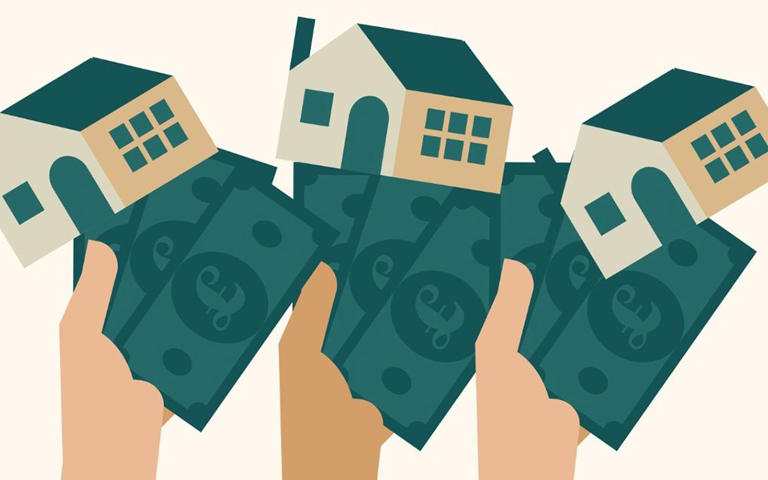Two pillars have long held up hundreds of thousands of retirement dreams: the stock market and the property market. Cracks have emerged in both this year. Savers relying on their workplace pension have watched the value of their pots sink, thanks to a twin sell-off in both the bond and stock markets.
Meanwhile, rising mortgage rates have hit buy-to-let profit margins, leaving a dent in landlords’ retirement plans. In the last 12 months alone, the average rate for a two-year fixed buy-to-let mortgage has more than doubled from 2.9% to 6.43%, according to the analyst Moneyfacts. Yet yields in the sector remain competitive compared with the income that most savers draw from a traditional pension – and could still rise.
The average gross yield on a new buy-to-let purchase still stands at a healthy 6%, according to the estate agent Hamptons. That is in contrast with a target 4% rate of income from a typical pension pot in drawdown. Experts have warned that the buy-to-let sector could suffer next year, as landlords face greater regulatory pressure to invest in energy upgrades, as well as the prospect of paying higher levels of tax under Government plans to cut capital gains allowance.
However Mark Harris, of the broker SPF Private Clients, argued that despite the regulatory changes dominating headlines, the market still looked attractive for people looking to invest over the longer term. “Demand for rental property is unlikely to fall anytime soon, with more people having to rent for longer because they can’t afford to buy, the need for good quality rental property at a reasonable price is higher than ever. What’s more, with a number of landlords selling up because the increased tax and regulatory burden has become too much, demand is only going to grow. If the rest of your investments have been in stocks, bonds and cash, it is good to have some exposure to bricks and mortar."
For workers near retirement with diminishing time to recoup their losses, the fate of the stock market next year is anxiety-inducing. Analysts at the investment bank Deutsche Bank have predicted that major stock markets could still fall a further 25% next year if the American economy enters a downturn.
However, Callum Stewart, of the pensions specialist Hymans Robertson, noted that stock markets would also recover over the long-term, and that savers should not rush to abandon their invested pots. A worker turning 66 next year could feasibly have almost two decades ahead of them to regain lost returns over the course of their retirement. “A defined contribution pension is generally invested in a well-diversified manner, meaning that while interest rates are rising or property markets experience headwinds, as they are now, your pension should be more resilient as it is exposed to a range of markets, not just one.”
But while headwinds in the property market have spooked many landlords, a correction could work in favour of investors looking for a buying opportunity. A house price fall could push up rental yields, drawing in more landlords seeking income.
Mr Harris added that despite much noise about house price falls next year, capital growth was not off the table for new investors in the sector. “Buy-to-let benefits from capital growth over the long term,” he said. “This means you can enjoy a regular and fairly predictable income, but also eventually benefit from capital appreciation should you decide to sell up and bank the profits.”

The size of pension needed for a ‘comfortable’ retirement
Workers need to have a nest egg of at least £645,000 if they want a comfortable lifestyle when they retire, new figures show.
A single person would require an annual income after tax of £26,700 on top of the full state pension, according to a report from the Pensions and Lifetime Savings Association. This would fund three weeks holiday in Europe each year, a £144 weekly budget for food and £56 on birthday presents.
That would require a private savings pot of at least £645,000 at age 66, based on current life expectancies and annuity rates, according to calculations by the wealth manager Quilter. A couple would require a private pot worth £797,000, it said.
A worker targeting a more moderate lifestyle would need less than half that amount, at £301,000, and a couple would need £294,000. This would allow for two weeks holiday in Europe, and around £74 a week on food.
A no-frills retirement would require a much smaller pot of £44,000. This would not budget for a car, but includes a week holiday within the UK and around £41 on a weekly food shop.
While more achievable, the cost of the minimum standard has grown the most in the past year, up by a record 18%, according to the PLSA. A retiree now needs a total £12,800 in annual income to cover their basic needs and live with dignity, it found. Last year the average cost was £10,900.
Jon Greer of Quilter noted that while the PLSA retirement living standards offered a rough guide for workers on how much they might need to save, it assumed that retirees lived rent or mortgage free.
“While these numbers make sense now, for future generations these figures will have to rise considerably. This is due to soaring house prices meaning that many struggle to find the money to buy a house or are forced to take out marathon mortgages with terms that stretch into their 70s to achieve lower monthly mortgage payments.”
Mr Greer added that the PLSA figures also did not account for the potential costs of requiring social care.
“Male healthy life is around 62.8 years and for women it is 63.6,” he said. “Life expectancy was 79.0 years for males and 82.9 years for females, meaning that many people will spend a significant proportion of their retirement in ill health potentially needing to access costly care.”
Experts have cautioned that many workers have not built up big enough nest eggs to see them through old age. Last week, the pensions regulator warned providers that the cost of living crisis could lead to some savers accessing cash from their pension to pay for essential bills, or cause them to stop their contributions altogether.

